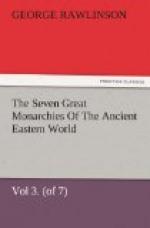Many Median names are absolutely identical with Persian; e.g., Ariobarzanes, Artabazus, Artaeus, Artembares, Harpagus, Arbaces, Tiridates, etc. Others which are not absolutely identical approach to the Persian form so closely as to be plainly mere variants, like Theodoras and Theodosius, Adelbert and Ethelbert, Miriam, Mariam, and Mariamne. Of this kind are Intaphres, another form of Intaphernes, Artynes, another form of Artanes, Parmises, another form of Parmys, and the like. A third class, neither identical with any known Persian names, nor so nearly approaching to them as to be properly considered mere variants, are made up of known Persian roots, and may be explained on exactly the same principles as Persian names. Such are Ophernes, Sitraphernes, Mitraphernes, Megabernes, Aspadas, Mazares, Tachmaspates, Xathrites, Spitaces, Spitamas, Ehambacas, and others. In Ophernes, Sitra-phernes, Mitra-phernes, and Mega-bernes, the second element is manifestly the pharna or frana which is found in Arta-phernes and Inta-phernes (Vida-frana), an active participial form from pri, to protect. The initial element in O-phernes represents the Zend hu, Sans, su, Greek ev, as the same letter does in O-manes, O-martes, etc. The Sitra of Sitra-phernes has been explained as probably Ichshatra, “the crown,” which is similarly represented in the Safro-pates of Curtius, a name standing to Sitra-phernes exactly as Arta-patas to Arta-phernes. In Mega-bernes the first element is the well-known baga, “God,” under the form commonly preferred by the Greeks; and the name is exactly equivalent to Curtius’s Bagfo-phanes, which only differs from it by taking the participle of pa, “to protect,” instead of the participle of pri, which has the same meaning. In Aspa-das it is easy to recognize aspa, “horse” (a common root in Persian names,) e.g., Aspa-thines, Aspa-mitras, Prex-aspes, and the like, followed by the same element which terminates the name of Oromaz-des, and which means either “knowing” or “giving.” Ma-zares presents us with the root meh, “much” or “great,” which is found in the name of the ilf-aspii, or “Big Horses,” a Persian tribe, followed by zara, “gold,” which appears in Ctesias’s “Arto-awes,” and perhaps also in Zoro-aster. In Tachmaspates, the first element is takhma, “strong,” a root found in the Persian names Ar-tochmes and Tritan-taechmes, while the second is the frequently used pati, “lord,” which occurs as the initial element in Pak-zeithes,” Pafa-ramphes, etc., and as the terminal in Pharna-jjates, Avio-peithes, and the like. In Xathrites we have clearly khshatra (Zend khshathra), “crown” or “king,” with a participial suffix -ita, corresponding to the Sanscrit participle in -it. Spita-ces and Spita-mas contain the root spita, equivalent to spenta, “holy,” which is found in Spitho-hates, Spita-mens, Spita-des, etc. This, in Spita-ces, is followed by a guttural ending, which is either a diminutive corresponding to the modern Persian -efc, or perhaps a suffixed article. In Spit-amas, the suffix -mas is the common form of the superlative, and may be compared with the Latin -mus in optimus, intimus, supremus, and the like. Ehambacas contains the root rafno, “joy, pleasure,” which we find in Pati-ramphies, followed by the guttural suffix.




